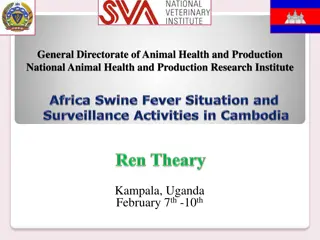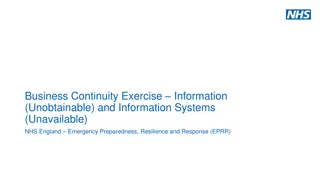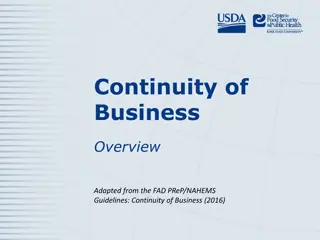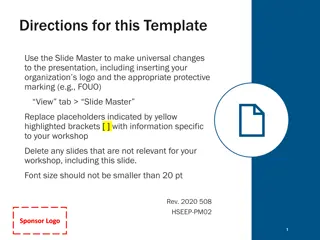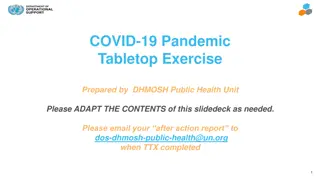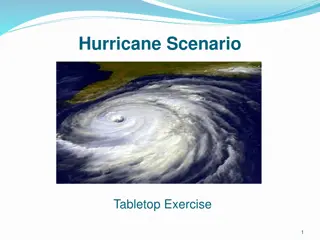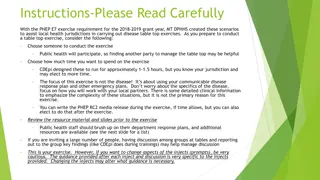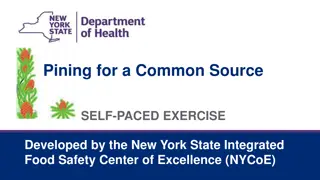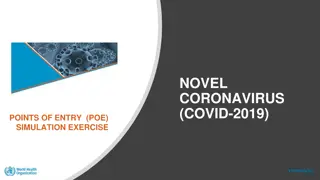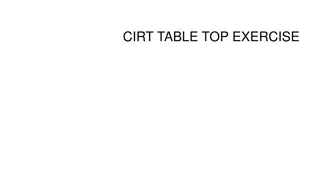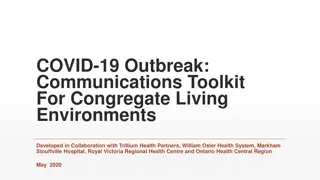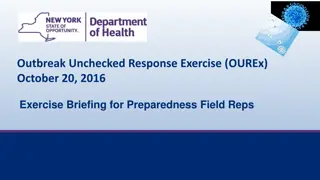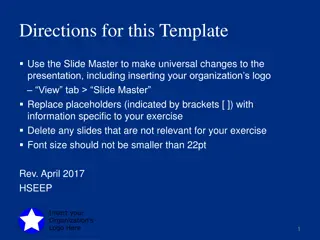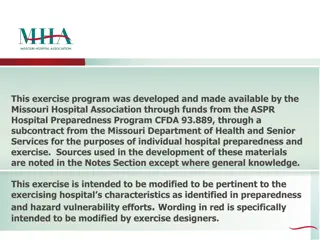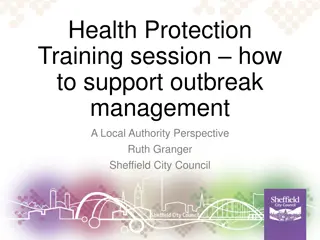Healthcare Preparedness for COVID-19 Outbreak - Exercise Objectives
Provide an opportunity to evaluate response concepts, plans, and capabilities for handling a novel viral disease outbreak. Objectives include minimizing morbidity, preserving social function, and improving hospital preparedness. Focus on surveillance, infection control, healthcare guidance, and communication processes.
- Healthcare Preparedness
- COVID-19 Response
- Pandemic Severity
- Exercise Objectives
- Planning Considerations
Download Presentation

Please find below an Image/Link to download the presentation.
The content on the website is provided AS IS for your information and personal use only. It may not be sold, licensed, or shared on other websites without obtaining consent from the author. Download presentation by click this link. If you encounter any issues during the download, it is possible that the publisher has removed the file from their server.
E N D
Presentation Transcript
Coronavirus Disease 2019 (COVID-19) Healthcare Preparedness Table Top Exercise
COVID-19 Response Objectives Overall objectives: Minimize morbidity and mortality from outbreak Preserve social function and minimize social disruption Response objectives: Surveillance Uniform infection and exposure control measures Healthcare guidance Public information Hospital surge support Fatality management
Pandemic Severity Pandemic Severity Assessment Framework
Purpose To provide an opportunity to evaluate current response concepts, plans and capabilities in response to an outbreak of a novel viral disease.
Exercise Objectives Improve preparedness for a response to a patient infected with novel coronavirus (COVID-19) presenting at a healthcare facility. Evaluate the hospital s capability to safely identify and effectively isolate a symptomatic patient at the facility. Assess the notification and communications processes internally with rostered staff and externally between local, regional, state public health, emergency medical services, other healthcare delivery partners, and media.
Exercise Objectives Assess just-in-time training for Personal Protective Equipment (PPE) donning/doffing and availability. Discuss the capabilities and capacities to sustain a prolonged medical surge novel virus outbreak event for both adult and pediatric patients. Assess planning for special considerations (surge capacity, diagnostic radiological imaging, laboratory services, waste management and decedent management).
Planning Considerations Timely recognition and isolation Personal protective equipment use Protection of healthcare workers, patients, and visitors Proper reporting to the Tennessee Department of Health Information management both internal and external Surveillance, contact tracing, and movement monitoring Maintaining normal hospital operations Laboratory services coordination Environmental and waste management Patient transportation
Participants Players: Players respond to the situation presented, based on expert knowledge of response procedures, current plans and procedures, and insights derived from training. Facilitators: Facilitators provide situation updates and moderate discussions. They also provide additional information or resolve questions as required. Observers: Observers support the group in developing responses to the situation during the discussion; they are not participants in the moderated discussion period, however, they may enhance the discussion by asking relevant questions or providing subject matter expertise. Evaluators: Evaluators evaluate and provide feedback on designated elements of the exercise and assess and document participants performance against exercise evaluation criteria.
Exercise Guidelines This tabletop will be held in an open, low-stress, no-fault environment. Varying viewpoints, even disagreements, are expected. Discussions are predicated on the basis of your knowledge of current plans and capabilities and insights derived from your training and experience. This tabletop is intended to be a learning environment for all participants. It is expected that experienced staff will share their knowledge and guide discussions. Discussion outcomes may serve to inform process/flow enhancements or changes as appropriate to improve the efficiency and effectiveness of information management and dissemination.
Exercise Assumptions In any tabletop, assumptions and artificialities may be necessary to complete play in the time allotted. During this exercise, the following apply: The scenario is plausible, and event discussions occur as they are presented. There is no hidden agenda, and there are no trick questions. All players receive information at the same time.
Background Coronaviruses are a large family of viruses that are common in people and many different species of animals, including camels, cattle, cats, and bats. Rarely, animal coronaviruses can infect people and then spread between people such as with MERS-CoV, SARS-CoV, and now with this new virus (named SARS-CoV-2). Refer to Situational Manual for Additional Information
Module 1: Patient Presentation (Estimated time: 40 mins)
Module 1: Scenario March 1, 2020 Earlier today, a 26 year-old pregnant female along with her 3 year old daughter presented to Community Hospital Emergency Department. She reports symptoms that include a 3-day history of fever (101.5), runny nose, cough and shortness of breath. She also states that she believes she and her family were exposed to a strep throat bug during their travel back to the United States. Upon arriving at the hospital, she informs the nurse that she and her 3 year old daughter have just returned from a tour of Northern Italy with her husband who is a Captain with a unit of the 101st Airborne.
Module 1: Questions Identify/ Isolate/ Inform 1. How does the Emergency Department triage and assess patients for a novel virus and other highly infectious diseases? Is the screening process the same throughout the Healthcare Coalition? 2. What notification or information sharing protocols will be enacted at your facility to address internal and external communication of a patient with a potential novel virus? 3. If a high risk patient is identified, what is the process for isolating the patient? 4. Identify three actions that your facility would be asking of your response partners to help you within the first 24 hours of this response, including Emergency Management, Public Health, Law Enforcement, Fire/EMS, and other Health Care Coalition Members?
Module 1: Questions Identify/ Isolate/ Inform 5. How would your facility request additional Personal Protective Equipment from the state or other partners from the Healthcare Coalition? What would be the implications if there were no resources available from the Tennessee Department of Health? 6. How would your facility request clinical consultation from the Tennessee Department of Health? Would your facility provide clinical expertise to outlying facilities in your Healthcare Coalition? 7. What are other issues that should be discussed at this time?
Module 2: Patient Admission (Estimated time: 45 mins)
Module 2: Scenario Upon further investigation, it is learned that the 26 year old female patient s symptoms began with slight fever, cough and sore throat. The 3 year old female pediatric patient symptoms began with high fever, runny nose and cough. The family had recently been on a vacation with her deployed husband to Northern Italy. They arrived back in Tennessee on February 26, 2020. The route home from Northern Italy included flights to Charlotte NC, Philadelphia PA, Rome and bus to Milan, Italy. Both patients visited numerous locations for three days while feeling sick before presenting at the ED on day three. No diagnostic testing has been performed on either patient and facility does not want to separate the pediatric patient from parent. Key Dates: February 20 Departed Italy February 26 Arrive in Tennessee February 28 Onset of symptoms March 1 Patient presents at Emergency Department
Module 2: Questions Specimens/Contacts/PPE 1. What preparations need to be done by the hospital to collect specimens? 2. What types of specimen are required to be collected and what is the process for collection? Does your facility have specific arrangements and protocols for delivery to Tennessee Department of Health State Laboratory for testing? 3. Who would handle identifying contacts within the facility? Would this process be coordinated with the Local Health Department? How would your facility address the potential exposure of other patients or staff prior to isolation? 4. Describe the process of identifying proper PPE for this novel virus. Does your facility s plan address strategies for optimizing supply of N95 respirators and other PPE?
Module 2: Questions Specimens/Contacts/PPE 5. What is the process to track the employees involved in direct and indirect patient care? Are they required to be monitored for an extended period of time? What if they have acute symptoms? 6. What information would your facility provide to media and the community regarding these patients? Who would be involved in making those decisions? 7. What protocols are in place to request transfer of this patient? Would there be a need for transfer to a facility with a higher level of care capability? Who would you notify to implement transfer? 8. What environmental infection control and cleaning processes are required once the patient with COVID-19 leaves the patient care area? 9. What are other issues that should be discussed at this time?
Module 3: Recovery Operations (Estimated time: 35 mins)
Module 3: Scenario After consultation with the state health department and approval of laboratory testing, both patients were confirmed positive for COVID-19 and subsequently recovered from their illnesses. The patients additional family members never became symptomatic. Contact tracing and monitoring continues with no new cases identified. The hospital is now attempting to return to normal operations, however, there are some legitimate concerns within administration about the perceived risk. The national news media has arrived.
Module 3: Questions Monitoring/Quarantine/Recovery 1. How do you perform employee temperature monitoring once the patient has been confirmed to have COVID-19? Will the employees be quarantined? If asymptomatic, will they be allowed to work? 2. How would employee information be shared with local and state public health? 3. What steps need to be taken for the hospital to return to normal operations? 4. How would your facility address deceased remains? Do you have morgue capacity to address a large surge of novel virus disease deaths?
Module 3: Questions Monitoring/Quarantine/Recovery 5. How will public perception, especially following what would likely be massive news interest in the case, have an impact on the provision of care at the hospital? 6. How will your facility track costs associated with a COVID-19 patient? 7. What are the other issues that should be discussed at this time?
Hotwash The purpose of the hotwash is to simply identify issues and not immediately address items that require future follow up. Conduct a hotwash to identify issues brought up during this exercise.
Evaluation Please complete an evaluation of the exercise and capture areas of strength and areas for improvements using the provided participant feedback form. Use this evaluation to improve your facility plans.
References 1. Triage, Assessment and other resources: https://www.tn.gov/health/cedep/ncov.html 2. Personal Protective Equipment (PPE): https://www.cdc.gov/coronavirus/2019-ncov/hcp/healthcare-supply-ppe-index.html 3. Laboratory Testing: https://www.cdc.gov/coronavirus/2019-ncov/lab/index.html 4. Preparedness Checklist for Hospitals: https://www.cdc.gov/coronavirus/2019-ncov/hcp/hcp-personnel-checklist.html 5. Interim U.S. Guidance for Risk Assessment and Public Health Management of Healthcare Personnel with Potential Exposure in a Healthcare Setting to Patients with Coronavirus Disease 2019 (COVID-19) https://www.cdc.gov/coronavirus/2019-ncov/hcp/guidance-risk-assesment-hcp.html


